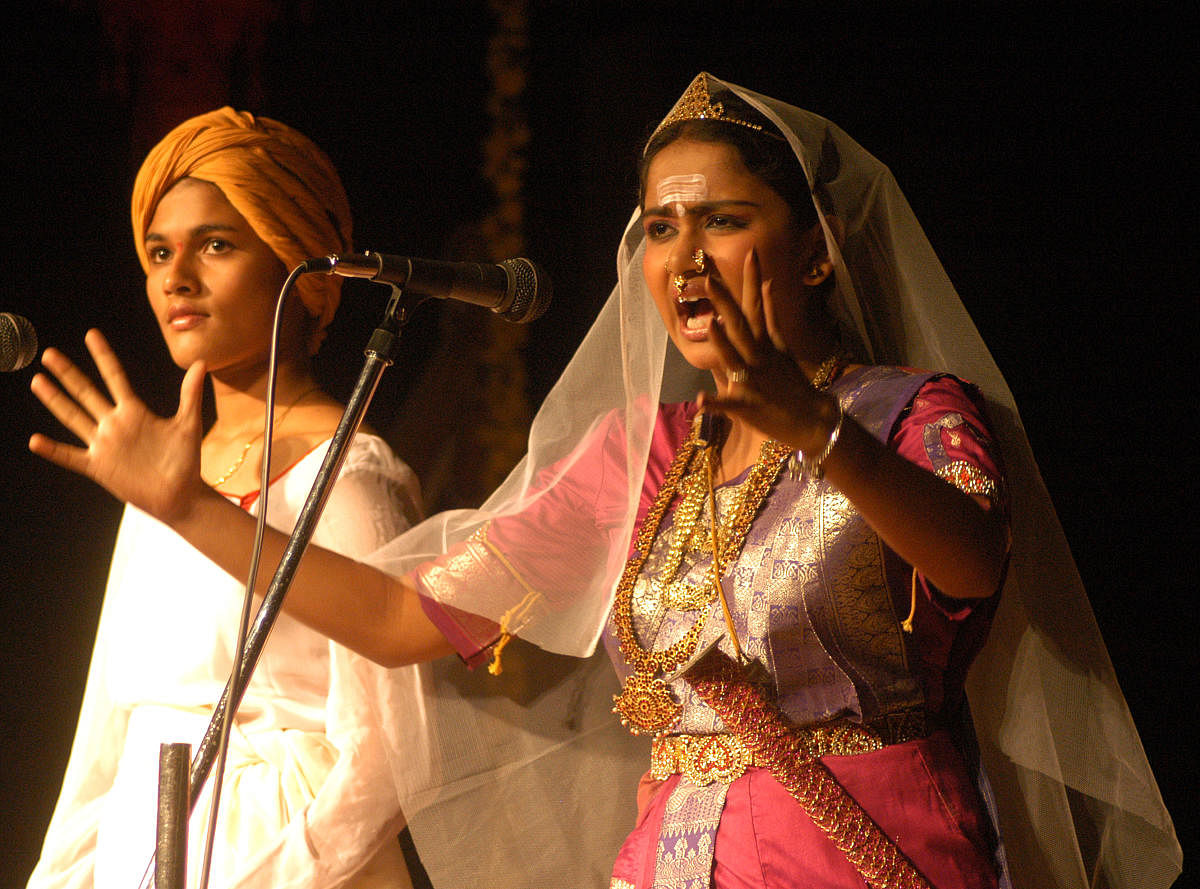

In North Karnataka, the freedom movement saw the involvement of professional theatre artistes and playwrights in voicing their dissent against British rule.
This was also a golden age of drama, where the form was a mix of western realism and Indian stylised theatre.
The playwrights also chose themes and characters from Indian mythology to allegorise the resistance to colonial rule. The irony was that these plays were staged in a proscenium — which was introduced in the country as a direct result of colonial rule.
Garud Sadashivarao (1882-1954) was one such playwright who was influenced by Bal Gangadhar Tilak and Mahatma Gandhi’s thoughts on the swadeshi and freedom movement.
All of Sadashivarao’s plays were staged through his own company, the Shri Dattatreya Sangeeta Nataka Mandali (1910-1945). And since Sadashivrao himself acted in leading roles in his plays, it was easy for him to communicate the aim of the freedom movement to the audience.
In one such play, Sri Rama Paduka Pattabhisheka, Lord Ram is the ideal king while Queen Kaikeyi represents Queen Victoria and her hunger for power.
In Lankadahana, Sadashivarao played the character of Maruti (Hanuman), who characterises Ravana’s abduction of Sita as the colonial theft of India’s pride.
When the play was staged in Vijayapur in 1935, the government asked for a few dialogues considered derogatory to British rule to be deleted.
In response, Sadashivarao turned the dialogues into a song. Set to choral music, the song was sung during Ravana’s entry into the royal court.
The audience were reportedly so moved that a few members came onto the stage during the scene and put a Gandhi topi on Maruti’s head, while shouting slogans of Bharat Mata Ki Jai.
The Mandali also raised funds for the freedom struggle through its benefit shows and provided refuge for freedom fighters at the time.
Kandagal Hanamantraya (1886-1966) was another prolific playwright who wrote nearly 50 plays for Company Theatre, most of them after India’s independence.
Mythological characters
A staunch nationalist who was influenced by Gandhi as well as Aurobindo and Swami Vivekananda, Hanamantraya was well-versed in Kannada epics and the literature of his contemporaries.
His plays were staged by several theatre companies in North Karnataka and were popular among the masses. Further, his penchant for choosing themes from the Mahabharata meant he was called Karnataka’s Shakespeare in theatre circles.
Akhsayambara or Draupadi Vastrapaharana written in 1935, has many shades of the swarajya and khadi movement.
Lord Krishna is the central figure of this play and protects Draupadi, and by extension, Mother India’s dignity.
Some clever wordplay also links Lord Krishna’s Sudarshana Chakra to the Charaka, and Lord Krishna then voices a preference for desi cloth as opposed to imported cloth.
The dramatist Nalavadi Srikantha Shastri (1889-1967), was a contemporary playwright of Kandagal Hanamantraya.
Srikantha Shastri was known for his harikatha (traditional religious theatre), which attracted people from all classes of society, and used the art form to promote nationalism. A strong believer in the khadi movement, he criticised colonial rule through plays like Bhakta Sudhanva, Dharmadroha, Ahiraavana–Mahiraavana, Hutatma Mylar Mahadeva.
Inspired by history
There were also a few historical plays based on kings, feudal lords and warriors who fought against colonial rule.
Tipu Sultan, Kittur Chennamma, Naragunda Bandaaya or Naragunda Babasaheb (King of Naragund in Gadag), Surapurada Venkatappa Nayaka (King of Surapur in Yadgir), Sangolli Rayanna, Veera Sindhura Laxmana (Warriors) were all popular subjects for these plays.
Company troupes who staged these shows often faced the ire of the British administration and a couple of shows were even banned.
There were also a few plays with social themes written in Kannada that spoke against the British rule.
However, the theatre of the time depended on larger than life characters, from mythology or history, to convey concepts of patriotism and nationalism. The ordinary person’s struggle against the colonial rule was not dramatised effectively.
But most plays effectively used spirited dialogue, which conveyed concepts from Gandhi’s swadeshi movement, the principle of ahimsa, unity, communal harmony and the abolition of untouchability.
Some plays worth mentioning are Nettarada Owtana (Feast of Blood) and August 15 ra Nantara (After August 15th) by Kandagal Hanamantaraya; Chaleejaav (Quit India) and Navayuga (New Age) written by Nalavadi Nalavadi Srikantha Shastri and Satyasankalpa (Determination of Truth) by Garud Sadashivarao.
Tiruguppu (Retreat) or Jagratarashtra written by Krishna Kumar Kallur (1909-1982) is another well-written play against colonial rule.
The play is based on the Quit India movement of 1942 and Gandhi’s call of ‘Do or die’ .
It also has a social theme based on an incident that took place at a small tea shop at Yaragatti cross in Belagavi district.
Narasamma, the owner of a tea shop, is the central character. Her shop is a hideout for freedom fighters.
Some scenes are rendered in the poetic, folk language of North Karnataka and highlights the fact that the spirit of nationalism and patriotism was not just limited to the urban middle class but had seeped down to touch the ordinary person in India’s villages as well.